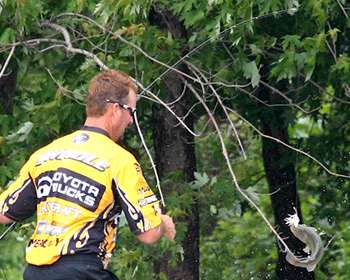
When heavy current makes the main stem of a river virtually unfishable, savvy bass anglers turn to backwater ponds and oxbows to fill their livewells. But not just any backwater will do.
Veteran Alabama pro Gerald Swindle says that on rivers featuring dozens of these out-of-the-way areas, there's a science to figuring out which ones are best and then maximizing your catch once you get there. "You're looking for two or three things," he says. "You're looking for a little bit clearer water and a little bit less current. You're also looking for a backwater that can harbor a lot of fish."
Another key factor is depth. "The valley of it needs to be 4 or 5 feet deep, something that fish can actually live in," Swindle adds. This is especially true when the water level is being drawn down. If areas that are holding fish today might be dry in a few days, that doesn't make for a very productive area in a multiday tournament.
That was the situation at the recent Elite Series River Rumble on the Mississippi River near Fort Madison, Iowa, where Swindle finished 11th. He spent as much of his allotted practice time looking for key areas as he did with a rod and reel in his hand. "On the first day of practice I burned $110 worth of gas in one pool," he recalls. "I looked in every canal and cranny, idling and pushing. I actually pushed and pushed and pushed.
The second day I looked and looked in the next pool and, when I finally got to my best area, I realized it was the biggest backwater and it had the best depth. It could harbor the most fish, and when I got bites I knew it was the one I had to be in to have a chance to win." The area was holding what he believed to be "resident bass" — not fish on their way to or from somewhere. They live in the backwaters through low river levels as well as flood situations. "I don't think those fish ever leave," he says. "Even in the (recent) flood, that pocket was protected, so it gave those fish somewhere to go. I think they stay in there."
Once he was inside the bay on tournament day, he had a host of other tournament competitors to deal with. Oftentimes he'd go down a bank that four other competitors had just fished. It takes great mental concentration to block that out, but it also takes an understanding of how the fish are changing from day to day. "One of the things that I actually did differently, something that helped me to get where I was in this tournament, was that I fished the pattern within the backwater," he says. "I didn't just say, 'Here's the backwater, let's just fish on down the bank.' I tried each day to adjust to wind, current, water clarity and boat traffic. "The fish one day swapped over and got on undercut banks," he explained. "We're only talking about a 6-inch variation in banks. It was crazy. I'd go behind people and just rip them on a spinnerbait. "You have to look at an area like that and read it each day, because each day it changes.
Treat the backwater like it's a little [Lake] Guntersville — if the wind changes and it's blowing on one side, go over there. If it's cloudy and rainy, try a spinnerbait. If it's sunny or slick, try a soft plastic and go with lighter colors because the pressure in there can be horrible. In this particular event, his key bait was a Zoom Magnum Finesse Worm. "I went with that because everybody around me was fishing Beavers and [other creature baits]," he says. "I opted for something a little more streamlined to try to trigger bites. I didn't want to go plopping in there with a big old craw. I knew the fish were feeding on shad. It's compact, goes in and out of cover well and they were eating it better. They would thump slack in my line."





